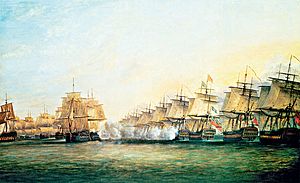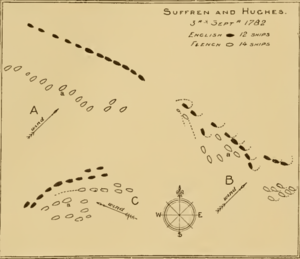Battle of Trincomalee facts for kids
Quick facts for kids Battle of Trincomalee |
|||||||
|---|---|---|---|---|---|---|---|
| Part of the American Revolutionary War | |||||||
 Battle of Trincomalee, Dominic Serres |
|||||||
|
|||||||
| Belligerents | |||||||
| Commanders and leaders | |||||||
| Strength | |||||||
| 12 ships of the line | 14 ships of the line | ||||||
| Casualties and losses | |||||||
| 51 killed 283 wounded |
82 killed 255 wounded |
||||||
The Battle of Trincomalee was a big naval fight between the British and French navies. It happened near Trincomalee, which is now in Sri Lanka, on September 3, 1782. This battle was part of the American Revolutionary War, even though it took place far away in the Indian Ocean. It was the fourth time the British fleet, led by Vice-Admiral Sir Edward Hughes, and the French fleet, led by the Bailli de Suffren, fought each other in this area. Neither side won a clear victory in this battle.
Contents
Why the Battle Happened
War in India and Europe
In 1778, France joined the American Revolutionary War to help the American colonies. This meant France and Britain were now at war. Later, in 1780, Britain also declared war on the Dutch Republic. This was because the Dutch were trading military supplies with France and America.
When news of these wars reached India, the British quickly took control of most French and Dutch bases there. This also led to another conflict called the Second Anglo-Mysore War.
Suffren's Mission
The French admiral, Bailli de Suffren, was sent to India to help the French colonies. He arrived in February 1782. Soon after, he fought Vice-Admiral Hughes's British fleet in a battle that didn't have a clear winner.
After fixing their ships, the two fleets met again in April. A storm and nightfall stopped that battle. Hughes went to Trincomalee, a port the British had recently captured. Suffren went to a Dutch-controlled port nearby. They fought a third time, again with no clear winner.
Capturing Trincomalee
Suffren needed a safe harbor to repair his ships properly. The place he was using was too open to attack. He decided to try and capture Trincomalee. This port was important because it offered a secure place for his fleet.
On August 21, 1782, two more French ships and eight transport ships carrying 800 soldiers joined Suffren's fleet. The next day, they sailed to Trincomalee.
Trincomalee Captured by France
On August 25, Suffren's soldiers landed east of the main fort. They set up cannons the next day and fired at the fort for three days. The fort's walls were badly damaged.
On August 30, the British commander, Captain MacDowall, was asked to surrender. After talking, the British soldiers gave up the fort. They were allowed to go to Madras (another city) and keep fighting in the war.
French troops entered Trincomalee on September 1. The very next day, Hughes's British fleet was seen coming towards the port.
Hughes Arrives
After their last battle, Admiral Hughes had spent time repairing his ships in Madras. Two more ships joined his fleet there. When his scouts told him the French were at Trincomalee, Hughes quickly sailed to help the British soldiers. But he arrived one day too late. The fort had already surrendered.
Suffren's Plan
Suffren's fleet was now safe inside the harbor. He held a meeting with his captains. Some of his captains didn't want to fight the British. But Suffren saw that his fleet had more ships than Hughes's. He believed destroying the British fleet would help the French and their allies on land. So, he ordered his fleet to sail out and fight.
A Confusing Start
As they left the harbor, Suffren signaled his ships to form a battle line. But his captains, who didn't want to fight, didn't follow the order well. The line was messy. Frustrated, Suffren then ordered them to hold fire until they were very close to the enemy. He fired a gun from his ship, Héros, to signal this.
However, his captains misunderstood the shot. They thought it was an order to start firing! So, the whole French line began shooting at the British fleet, starting the battle.
The Main Fight
The most intense fighting happened in the middle of the battle lines. Suffren on Héros fought directly against Hughes on Superb. Suffren's ship was helped by Illustre and Ajax. Hughes's ship was helped by Burford, Sultan, Eagle, Hero, and Monarca.
This uneven fight lasted about an hour. Suffren signaled for help, but some of his captains, like those on Saint-Michel and Annibal, stayed away. Brillant eventually came closer to help. About 30 minutes later, Ajax had to leave the battle because it was badly damaged. Artésien took its place.
An hour after that, the situation became very serious for Suffren. The main mast of his ship, Héros, fell down. He had to quickly make sure the British didn't think he was giving up. He had also run out of cannonballs. He kept firing just gunpowder to trick the enemy into thinking he was still fighting.
Battle on the Edges
On the ends of the battle lines, the French were doing better. British ships like Isis, Worcester, and Monmouth were badly damaged. Exeter was disabled, and its captain was killed.
At 5:30 PM, after about three hours of fighting, the wind suddenly changed. This gave the French fleet an advantage. The ships on the outer ends of their line, which hadn't fought much, could now join the main battle. This made the fighting even more intense. Hero lost two of its masts, and Worcester lost its main topmast. Several British ships were disabled before nightfall ended the battle.
What Happened Next
Repairs and Retreat
It seems Suffren tried to chase Hughes's fleet as they left for Madras. The French fleet went into Trincomalee harbor to fix their many damaged ships. The British fleet was so badly damaged that their commanders on land called back soldiers from the field. They were worried the French might attack Madras.
Punishing Disobedience
Just like after the previous battle, Suffren arrested three of his captains. He sent them away for punishment because they didn't follow his orders during the battle. Even the British noticed how poorly Suffren's captains supported him. One newspaper said they were "unworthy to serve so great a man."
Suffren left Trincomalee on September 30 and arrived at another port on October 4. Eleven days later, he sailed to Achin for the winter.
Hughes, who didn't want to stay in the open harbor of Madras during the monsoon season, sailed to Bombay. His entire fleet struggled through the start of the monsoon, and some ships took two months to get there.
Images for kids



